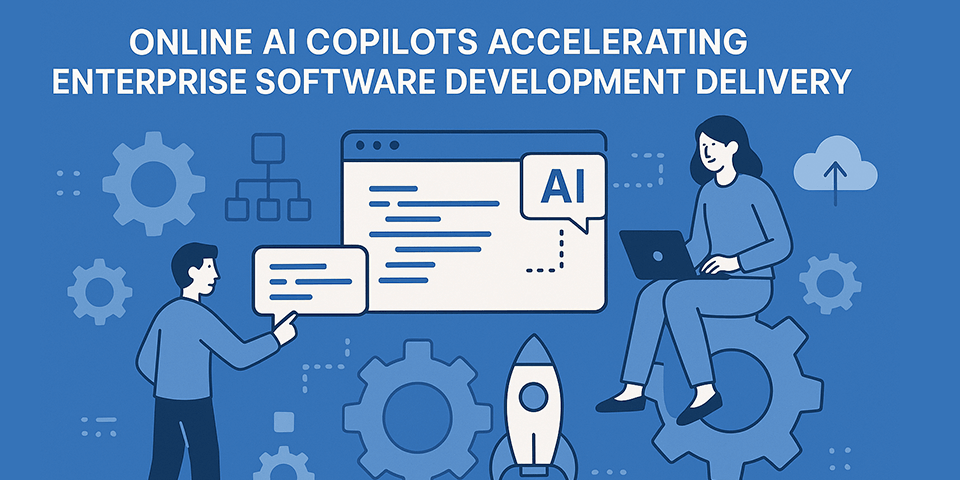Online AI Copilots Accelerating Enterprise Software Development and Delivery
The evolution of enterprise software development has always been defined by one driving goal: efficiency without compromise. Over the past two decades, businesses have invested heavily in automation, agile methodologies, and cloud-native infrastructure to shorten delivery cycles. Yet despite these advances, development teams still face persistent challenges—rising complexity, mounting technical debt, and increasing expectations for rapid innovation.
The latest paradigm shift comes from an unexpected ally: artificial intelligence copilots. Unlike traditional tools that simply execute predefined commands, AI copilots assist developers dynamically—interpreting intent, suggesting improvements, and learning from human feedback in real time.
As these systems become deeply embedded in online development environments, they are not merely augmenting productivity—they are redefining how enterprise software is designed, built, and deployed.
From Automation to Collaboration: The Emergence of AI Copilots

Automation in software engineering has traditionally focused on repetitive tasks: continuous integration, automated testing, and deployment pipelines. These systems improved speed but did not address the cognitive workload of development itself. The introduction of AI copilots marks a shift from mechanistic automation to cognitive collaboration.
An AI copilot operates as a contextual assistant. It reads and interprets code, identifies potential errors, and generates suggestions that align with the developer’s goals. By leveraging large-scale language models trained on billions of code examples, copilots can predict what a developer might write next or offer multiple implementation options for a given function.
This collaboration is not one-sided. As developers accept, modify, or reject suggestions, the copilot adapts—learning from real-world context and individual preferences. Over time, the interaction evolves into a form of symbiotic intelligence: human creativity complemented by algorithmic precision.
The size of the global artificial intelligence market was estimated at USD 279.22 billion in 2024 and is expected to grow at a compound annual growth rate (CAGR) of 31.5% from 2025 to 2033, reaching USD 3,497.26 billion by 2033. The demand for AI-powered solutions is increasing across various industries, driving this rapid growth and enhancing efficiency. With Copilot’s ability to enhance developer productivity and code quality, it is poised to play a significant role in shaping the future of AI development.
The Online Shift in Software Workflows

The transition to online and cloud-based development environments has been a key enabler of AI copilots. Modern enterprises increasingly rely on integrated development platforms that enable distributed teams to collaborate in real-time. These environments provide copilots with access to version histories, documentation, and workflow data—creating a feedback loop that enhances contextual understanding.
This online infrastructure also enables scalability. Instead of local installations, AI copilots can be deployed as cloud services, continuously updated with the latest training models and security protocols. As a result, organizations no longer need to manage complex on-premises configurations; they can simply integrate copilots into their existing toolchains through APIs or extensions.
Furthermore, online collaboration amplifies the learning potential of AI systems. When copilots analyze code across thousands of enterprise projects (in compliance with privacy and governance frameworks), they generate insights that extend beyond any single team. Patterns in bug detection, architecture optimization, and code reuse become part of a collective intelligence accessible to all users.
Business process automation is streamlined as AI copilots can quickly identify bottlenecks and suggest improvements based on industry best practices. This enables organizations to achieve greater efficiency and innovation in their software development processes.
Accelerating Enterprise Software Development
The impact of AI copilots on enterprise software development extends far beyond individual productivity. At scale, these tools transform organizational dynamics. They accelerate development cycles, reduce onboarding friction, and enhance code quality across distributed teams.
Rapid Prototyping and Ideation
AI copilots help teams move from concept to prototype in record time. Developers can describe functionality in natural language, and the copilot generates initial code structures instantly. This ability bridges the gap between technical and non-technical stakeholders, fostering faster iteration and alignment.
Error Reduction and Debugging
Traditional debugging is reactive—errors are found after compilation or testing. Copilots introduce a proactive layer, identifying potential issues as code is written. By suggesting alternative logic or flagging performance bottlenecks early, they reduce downstream costs and prevent regressions.
Knowledge Retention and Transfer
In large enterprises, developer turnover frequently results in knowledge loss. AI copilots mitigate this by internalizing organizational coding patterns and best practices. New developers benefit from immediate guidance aligned with company standards, which reduces onboarding time and maintains consistency.
Security and Compliance Assistance
Security vulnerabilities often stem from human oversight. AI copilots trained on secure coding practices can flag common exploits such as injection attacks, insecure dependencies, or misconfigurations. When integrated into enterprise pipelines, this capability strengthens compliance with regulatory frameworks.
Continuous Improvement Through Data Feedback
Every interaction between developers and copilots contributes to a growing repository of organizational intelligence. By analyzing feedback loops—what suggestions are accepted, ignored, or modified—AI systems learn to tailor their recommendations to specific project needs.
Together, these factors redefine how enterprises conceptualize software delivery: not as a static process, but as an evolving conversation between human insight and machine assistance. Intelligent automation not only streamlines development processes but also enhances decision-making by providing real-time insights and predictive analytics. This collaborative approach ultimately leads to more efficient and effective software delivery, driving innovation and competitiveness in the market.
The Role of AI in Software Design and Architecture

While AI copilots excel at writing and refactoring code, their true potential lies in architectural intelligence. As enterprises move toward microservices, containerization, and distributed systems, design decisions become exponentially more complex. Copilots equipped with architectural heuristics can assist in selecting frameworks, balancing load distribution, and optimizing data pipelines.
For example, when designing a microservices architecture, a copilot might recommend decomposing a monolith into independent services based on historical usage data or performance metrics. In data-heavy applications, it can suggest optimal database indexing strategies or caching mechanisms derived from similar projects.
These contributions extend the role of AI beyond syntax assistance into strategic decision-making. Over time, copilots may become co-architects—analyzing system dependencies, forecasting scalability issues, and generating visual documentation that evolves with each iteration.
Upskilling Through AI Collaboration
One of the most promising byproducts of AI copilots is their educational value. Developers working alongside these systems gain immediate access to contextual examples and best practices. Instead of searching documentation or forums, they receive in-line explanations tailored to their exact scenario.
This “learning by doing” approach accelerates skill acquisition across all experience levels. Junior developers build confidence faster, while senior engineers offload routine tasks to focus on complex problem-solving. As AI copilots evolve, they could even integrate adaptive learning modules—recommending targeted tutorials or exercises based on observed skill gaps.
This convergence of education and application is mirrored in the academic world. Many institutions now offer online AI degree programs that combine theoretical concepts with practical applications. These programs emphasize how developers can leverage AI tools within enterprise workflows—an essential skill as copilots become standard features of modern development environments.
Challenges and Ethical Considerations
Despite their potential, AI copilots introduce complex challenges that enterprises must navigate carefully.
Code Ownership and Attribution
Since copilots generate code based on large-scale training data, questions arise about intellectual property rights and authorship. Enterprises must establish governance frameworks to ensure clarity on who “owns” AI-assisted output.
Data Privacy and Security
Copilots learn from user interactions, which may include sensitive codebases or proprietary logic. Ensuring that training and inference processes comply with internal privacy policies and external regulations is critical.
Bias and Model Integrity
Like any AI system, copilots can inadvertently propagate biases embedded in their training data. These biases may manifest as inefficient algorithms, insecure configurations, or outdated design choices. Continuous auditing and fine-tuning are necessary to maintain reliability.
Overreliance and Skill Degradation
The convenience of AI assistance carries the risk of skill atrophy. Developers who rely excessively on automated suggestions may lose the ability to reason deeply about architecture or optimization. Organizations must strike a balance between automation and intentional skill development.
Transparency and Trust
To be effective collaborators, AI copilots must be explainable. Developers need visibility into why a specific suggestion was made or how a model evaluated certain trade-offs. Without transparency, trust in AI-driven workflows erodes quickly.
Addressing these concerns requires a multidisciplinary approach that combines technical governance, ethical foresight, and continuous education.
Integration Across the Enterprise Stack
Enterprise software ecosystems are rarely homogeneous. They comprise legacy systems, modern cloud platforms, and third-party APIs. AI copilots designed for modular integration can operate seamlessly across this heterogeneity.
By connecting to issue trackers, project management systems, and CI/CD pipelines, copilots can contextualize development in terms of broader business goals. For instance, they can prioritize bug fixes that impact critical customer journeys or suggest code optimizations tied to key performance indicators.
Furthermore, copilots can facilitate communication between technical and non-technical teams. When integrated with documentation platforms, they automatically summarize technical updates in plain language, ensuring that stakeholders across departments understand project progress and implications.
This holistic integration transforms software development from a siloed engineering function into a cross-organizational dialogue.
Measuring Impact: From Code Metrics to Business Value
Enterprises adopting AI copilots often begin by tracking productivity metrics—such as faster code completion, fewer bugs, and reduced testing cycles. While these indicators are valuable, the true measure of success lies in business outcomes.
For example, reduced time-to-market for new features directly correlates with competitive advantage. Improved code quality lowers maintenance costs and enhances customer satisfaction. Enhanced developer morale, stemming from reduced cognitive load, translates into better retention and innovation rates.
AI copilots also contribute to operational intelligence. By analyzing aggregated development data, organizations can identify inefficiencies, forecast resource demands, and align IT strategies with broader business objectives.
Thus, the value of AI copilots extends beyond code—it encompasses the entire digital transformation journey of an enterprise.
The Future of Collaborative Development
The trajectory of AI copilots suggests a future where software development becomes increasingly conversational. Instead of writing complex commands or configurations, developers will describe desired outcomes in natural language, and the copilot will translate those goals into executable logic.
This evolution will blur traditional boundaries between engineering, design, and operations. Development environments may evolve into multi-agent ecosystems where specialized AI copilots—focused on testing, architecture, documentation, or deployment—collaborate with one another under human supervision.
In this scenario, the developer’s role transitions from code author to system orchestrator—guiding and curating machine-generated output rather than manually producing every line. The creative focus shifts from implementation to innovation, from syntax to strategy.
Conclusion
Online AI copilots are transforming enterprise software development and delivery by merging automation with cognitive assistance. They enable faster iterations, higher-quality code, and greater strategic alignment across organizations. Beyond productivity gains, their true significance lies in how they redefine collaboration—between humans and machines, teams and systems, strategy and execution.
The future of enterprise software is not just faster or smarter—it is symbiotic, built on a continuous exchange of human judgment and artificial intelligence.







